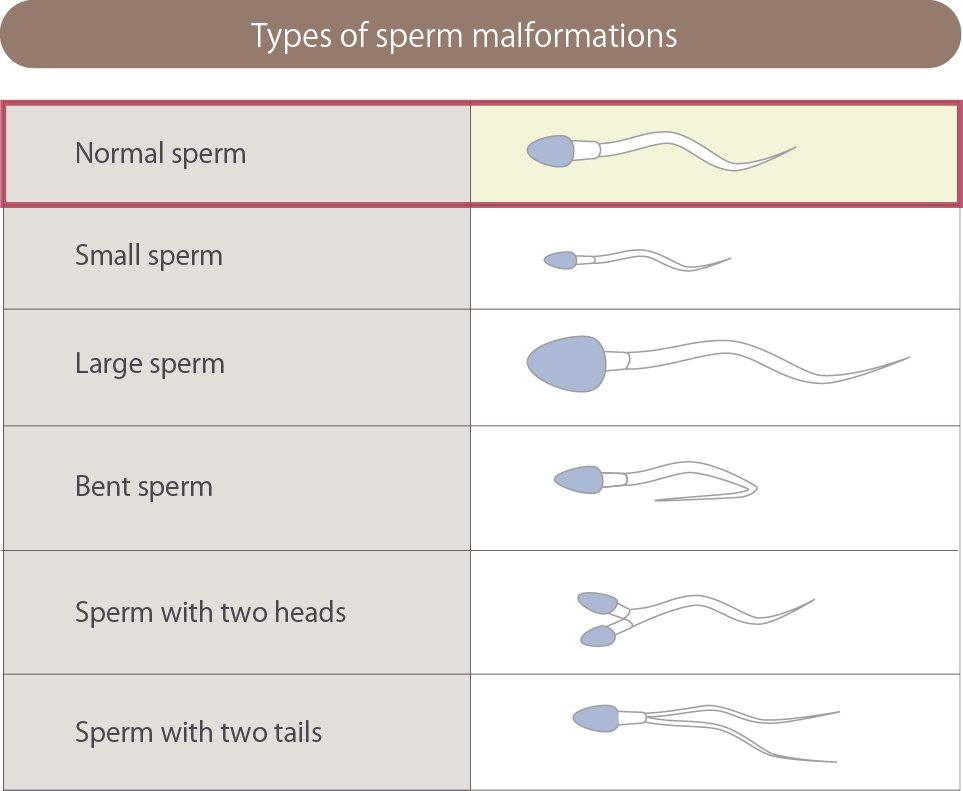It is the “spermatogenic dysfunction”, that is the failure to make sperm, which is overwhelmingly a common cause of male infertility.

Oligospermia
It is a condition where there are only a few sperm.
In general, oligospermia is defined as the number of spermatozoa in 1ml of semen is less than 15 million.
The number of sperm in 1 ml of healthy male semen is said to be in the hundreds of millions, so the number is quite low in comparison.
There are three degrees of oligospermia depending on the number of sperm in 1 ml of semen.
-
light(Less than 15 million)
-
Moderate(Less than 10 million)
-
Advanced(Less than 5 million)
A sperm count in the semen below the threshold does not necessarily mean that conception is difficult.
There are many causes of male infertility, especially as determined by sperm motility, and oligozoospermia is often associated with asthenospermia (a case of poor sperm motility).

Asthenospermia
It is a bad state of the motility rate of the sperm.
Sperm motility refers to the ability to move forward, and the motility of sperm in healthy men is said to be 55%.
On the other hand, it is said that asthenospermia is diagnosed when the motility of sperm is less than 40% and 25-30% of sperm move forward.
Sperm motility is believed to be strongly influenced by mitochondria.
Asthenospermia is said to be caused by environmental hormones and other toxic substances, as well as diet and stress, but these possibilities are not clearly understood.
Depending on the progress and condition, we will do artificial insemination, in vitro fertilization or micro-insemination.

Sperm Malformation
It is a condition where there are many sperms that are malformed.
According to the World Health Organization (WHO), the percentage of normal spermatozoa is 4%, and if 96% or more are malformed, it is diagnosed as teratozoospermia.
Even in healthy men, more than 80% of sperm are malformed, and normal sperm account for 20-15%.
In addition, the percentage of normal sperm retained is said to be decreasing year by year.
Malformed sperm can be congenital or acquired factors.
If there are many clearly malformed sperm, most cases are congenital abnormalities.
On the other hand, mildly malformed sperm are considered to be an acquired factor, caused by stress (lack of sleep, alcohol consumption, poor diet, electromagnetic radiation) and lifestyle.
It is said that malformed sperm tend to have a lower probability of conception than normal sperm, but conception is possible, and it has not been determined that the baby will be affected.
In some cases, even sperm with normal shape can cause male infertility due to DNA damage.

Azoospermia
Azoospermia is the absence of sperm in semen.
If semen is tested twice and no sperm are found in the semen on both occasions, azoospermia is diagnosed.
About 1 in 100 general people are said to have azoospermia, and 1 in 10 male infertility is said to be caused by azoospermia.
Azoospermia is classified into two factors.
-
Obstructive azoospermia (testicles are functioning and producing sperm but not in semen)
-
Non-obstructive azoospermia (the function to produce sperm is not working)
If you are diagnosed with azoospermia, it is almost impossible to improve with medication.
Therefore, we try to collect sperm from the testis and epididymis by microscopic testicular sperm extraction (MD-TESE).
If even one sperm is found, pregnancy is possible with ICSI, which directly injects the sperm into the egg.

Other Sperm Abnormalities
Other possible causes of sperm abnormality besides sperm shape, sperm count in semen, and sperm motility status,
-
Low semen volume
-
White blood cells are above the standard value
(not good if there are many because it indicates inflammation)
Such will be considered.
High levels of white blood cells in semen are said to decrease sperm motility and thus make fertilization difficult.
At our hospital, we judge and treat based on the sperm standard value shown by WHO.
Volume of Semen
1.4ml or
greater
White blood cell count
Less than 1 million
per 1 ml
Semen Reference Value(Issued by the WHO in 2021)
|
Volume of Semen
|
1.4ml or greater
|
|
Concentration of Sperm
|
At least 16 million per 1 ml
|
|
Motility rate
|
42% or greater
|
|
Total motile sperm count
|
9.4 million
|
|
Progressive
|
30% or greater
|
|
Normal morphology
|
4% or greater
|
|
Abnormal/Malformation rate
|
96% or less
|
|
White blood cell count
|
Less than 1 million per 1 ml
|











